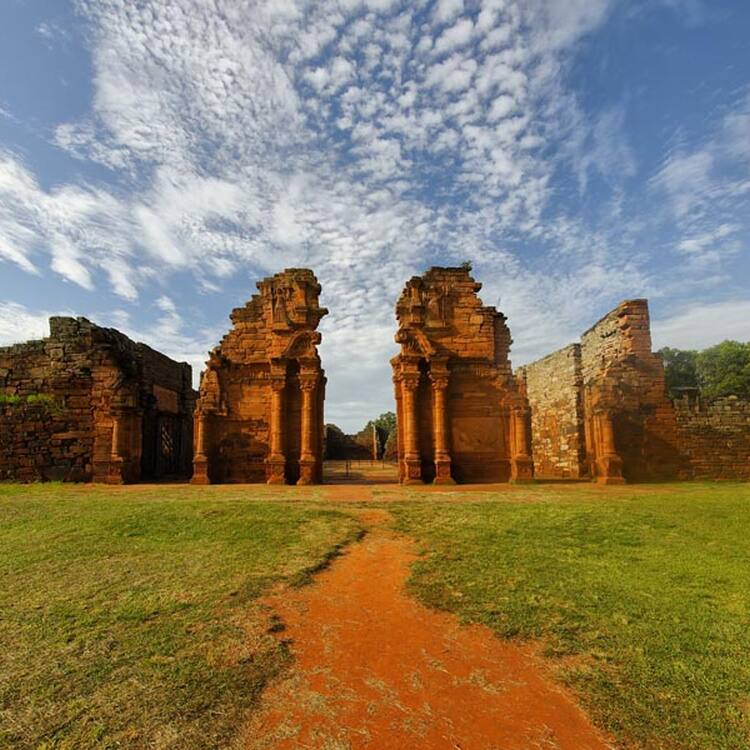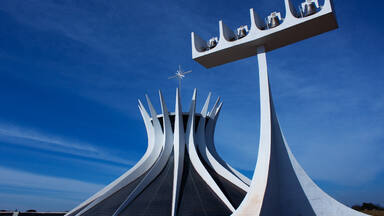Jesuit Missions of the Guaranis: San Ignacio Mini, Santa Ana, Nuestra Señora de Loreto and Santa Maria Mayor (Argentina), Ruins of Sao Miguel das Missoes (Brazil)
Jesuit Missions of the Guaranis: San Ignacio Mini, Santa Ana, Nuestra Señora de Loreto and Santa Maria Mayor (Argentina), Ruins of Sao Miguel das Missoes (Brazil)
The ruins of São Miguel das Missões in Brazil, and those of San Ignacio Miní, Santa Ana, Nuestra Señora de Loreto and Santa María la Mayor in Argentina, lie at the heart of a tropical forest. They are the impressive remains of five Jesuit missions, built in the land of the Guaranis during the 17th and 18th centuries. Each is characterized by a specific layout and a different state of conservation.
Description is available under license CC-BY-SA IGO 3.0
Missions jésuites des Guaranis : San Ignacio Mini, Santa Ana, Nuestra Señora de Loreto et Santa Maria Mayor (Argentine), ruines de Sao Miguel das Missoes (Brésil)
Au cœur de la forêt tropicale, les ruines de São Miguel das Missoes, au Brésil, et celles de San Ignacio Mini, de Santa Ana, de Nuestra Señora de Loreto et de Santa Maria la Mayor, en Argentine, sont les remarquables vestiges de cinq missions jésuites édifiées aux XVIIe et XVIIIe siècles sur le territoire des Guaranis, chacune d’entre elles se caractérisant par ses dispositions particulières et un état de conservation inégal.
Description is available under license CC-BY-SA IGO 3.0
البعثات اليسوعية في غوارانيس: سان إغناسيو ميني، سانتا أنا، سيدة لوريتو، سانتا ماريا مايور (الأرجنتين) وآثار ساو ميغال داس ميسويس (البرازيل)
إن آثار ساو ميغال داس ميسويس في البرازيل وآثار سان إغناسيو ميني وسانتا أنا وسيدة لوريتو وسانتا ماريا مايور في الأرجنتين والتي تقع كلّها وسط الغابة الاستوائية هي آثار مذهلة لخمس بعثات يسوعيّة شُيّدت في القرنين السابع عشر والثامن عشر على أراضي غوارانيس وتتميّز كل واحدة منها بموقعها وبطريقة صيانتها الفريدة.
source: UNESCO/CPE
Description is available under license CC-BY-SA IGO 3.0
瓜拉尼人聚居地的耶稣会传教区:阿根廷的圣伊格纳西奥米尼、圣安娜、罗雷托圣母村和圣母玛利亚艾尔马约尔村遗迹以及巴西的圣米格尔杜斯米索纳斯遗迹
在热带雨林的中心地带,有五个引人注目的耶稣会传教区遗址,他们分别是:巴西的圣米格尔杜斯米索纳斯遗迹,阿根廷的圣伊格纳西奥米尼、圣安娜、罗雷托圣母村和圣母玛利亚艾尔马约尔村遗迹。他们建于17至18世纪的瓜拉尼人地区。各处遗址布局迥异,保护状况各不相同。
source: UNESCO/CPE
Description is available under license CC-BY-SA IGO 3.0
Иезуитские миссии на землях индейцев гуарани: Сан-Игнасио-Мини, Санта-Ана, Нуэстра-Сеньора-де-Лорето и Санта-Мария-ла-Майор (Аргентина); руины Сан-Мигел-дас-Мисойнс (Бразилия)
Руины Сан-Мигел-дас-Мисойнс в Бразилии, также как и Сан-Игнасио-Мини, Санта-Ана, Нуэстра-Сеньора-де-Лорето и Санта-Мария-ла-Майор в Аргентине, находятся в гуще тропического леса. Это впечатляющие остатки пяти иезуитских миссий, построенных на землях индейцев гуарани в течение XVII-XVIII вв. Каждая из них имеет специфическую планировку и различную степень сохранности.
source: UNESCO/CPE
Description is available under license CC-BY-SA IGO 3.0
Misiones jesuíticas de los guaraníes: San Ignacio Miní, Santa Ana, Nuestra Señora de Loreto y Santa María la Mayor (Argentina), ruinas de Sao Miguel das Missoes (Brasil)
En el corazón mismo de la selva tropical están ubicadas las ruinas de cinco misiones jesuitas: San Miguel de las Misiones (Brasil), San Ignacio Miní, Santa Ana, Nuestra Señora de Loreto y Santa María la Mayor (Argentina). Construidas en territorio guaraní durante los siglos XVII y XVIII, estas misiones se caracterizan por su trazado específico y su desigual estado de conservación.
source: UNESCO/CPE
Description is available under license CC-BY-SA IGO 3.0
グアラニーのイエズス会伝道施設群:サン・イグナシオ・ミニ、サンタ・アナ、ヌエストラ・セニョーラ・デ・ロレート、サンタ・マリア・ラ・マジョール(アルゼンチン)、サン・ミゲル・ダス・ミソオエス遺跡群(ブラジル)
イエズス会の宣教師が、南米の先住民グアラニー人との信仰共同体をめざして拓いた伝道村。イグアスの滝の近く、ブラジルとアルゼンチンにまたがったところにある。教会や学校などの諸施設を備えていたが、18世紀後半スペイン国王の命令で宣教師は追放され、村だけが遺跡として残っている。source: NFUAJ
Jezuïtische missieposten van de Guarani
In het hart van een tropisch bos liggen de ruïnes van Sao Miguel das Missoes (Brazilië), San Ignacio Mini, Santa Ana, Nuestra Señora de Loreto en Santa Maria Mayor (Argentinië). Het zijn de indrukwekkende overblijfselen van vijf Jezuïtische missieposten die gebouwd werden op het land van de Guarani in de 17e en 18e eeuw. De Guarani nederzettingen zijn aangelegd volgens eenzelfde model; een groot plein met daaromheen de kerk, de woonplaats van de kerkvaders en de - qua afstand regelmatig verspreide - huizen van de Indianen. Toch is elke ruïne unieke vanwege z'n specifieke inrichting en staat van onderhoud.
Source: unesco.nl
Outstanding Universal Value
Brief synthesis
Jesuit Missions of the Guaranis, a serial transnational property, consists of the ruins of São Miguel Arcanjo in Brazil, and those of San Ignacio Miní, Santa Ana, Nuestra Señora de Loreto, and Santa María la Mayor in Argentina. These are the impressive remains of Jesuit Mission settlements established in the 17th and 18th centuries on lands originally occupied by Guarani indigenous communities. In Brazil, the ruins of the São Miguel Arcanjo church constitute the most intact and complete structure among this period’s designated heritage properties. In Argentina, the four Jesuit-Guarani Missions, located in the southern Misiones province, provide an exceptional example of systematic and organized territorial occupation.
The properties’ surviving ruins depict the experience of the Society of Jesus in South America, where there emerged a singular system of spatial, economic, social, and cultural relations in 30 settlements – referred to as reducciones – that included ranches, mate plantations, and networks of trails and waterways extending across the Uruguay River and its tributaries. This particular model of the reducciones also included smaller structures and constructions designed to support the basic functions of the settlements. Together, these elements, each closely integrated within productive lands, and each manifesting the distinct potential and complementary traits of the various settlements and the other Jesuit provinces in the region, inform this underlying interpretation, reflected by the serial heritage property in a singular and specific fashion.
An integral part of the evangelization campaigns, the Missions stand as an important testament to the systematic occupation of the area and to the cultural relations forged between the area’s indigenous populations, mostly Guarani, and the European Jesuit missionaries.
Criterion (iv): The surviving remains of the Jesuit Missions of the Guaranis represent outstanding examples of a type of building and of an architectural ensemble that illustrate a significant period in the history of Argentina and Brazil. They are a living testament to Jesuit evangelization efforts in South America.
Integrity
The majority of the components that convey the Outstanding Universal Value of the 265.78 ha serial transnational property are contained within the boundaries of the designated zones. On the Argentinean side, three out of the four Missions (Santa Ana, Loreto, and Santa María) have either maintained their original rural configuration or have been subject to minor modifications. By contrast, the fourth Mission, San Ignacio, is located within the urban grid of the city of San Ignacio. On the Brazilian side, the surviving material traces and evidence of the São Miguel Arcanjo Mission, including the main body of the church as well as the belfry and the sacristy, portions of the convent structures, the surviving foundations of the indigenous dwellings, the square, the vegetable garden, the storm drains, and the sacred objects, converge to give expression to a singular model of territorial occupation permeated by the cultural interaction and exchange between the indigenous populations and European missionaries.
Over time, these structures lost their original religious, residential, educational, and cultural functions. Today, the various Missions include fragments of walls corresponding to the original monuments (churches, dwellings, workshops, orchards). Their archaeological remains are deemed historic monuments and important to the development of the respective local communities. In exceptional cases, they are used for religious or recreational events. None of the components of the serial transnational property are under threat, having been preserved through direct government action in both Argentina and Brazil.
Authenticity
The components of the property have maintained the two basic intersecting compositions: first, the European convent, constituted by a main church, residence, and school; and secondly, a section occupying the remaining three sides of the central square erected primarily for the local indigenous populations. Conservation work in the case of San Ignacio Miní has enabled the overall preservation of the existing urban architectural scale. Conservation work has also been carried out in order to preserve the Argentinean monuments and to facilitate responsible tourism.
In the Brazilian case, a full reading and understanding into the spatial configuration of São Miguel Arcanjo is provided in a set of surviving documents. The site’s physical authenticity has been maintained through the preservation of the original construction materials and techniques. The series of interventions executed since the time the reducción was in operation have all been duly recorded and mapped. The interventions have aimed at ensuring the property’s structural stability.
Protection and management requirements
The five components of the serial transnational property are State-owned, and their management is undertaken by the two countries – Brazil and Argentina – at the respective archaeological sites located in their national territories. In Brazil, the ruins of São Miguel Arcanjo, in São Miguel das Missões municipality, were inscribed by the National Historic and Artistic Heritage Institute (Instituto do Patrimônio Histórico e Artístico Nacional - IPHAN) in 1938, number 0141-T-38. In 2009, the National Historic Park of Missões (Parque Histórico Nacional das Missões) was established, aiming to provide integrated and complementary management of the Mission territories in Brazil, facing the challenge of the usage of cultural heritage to support the socio-economic development of local communities.
IPHAN, the responsible institution to provide the technical structures necessary to manage and conserve the cultural heritage, has participated throughout the years as an articulator, providing guidelines in order to regulate the urban planning in the areas surrounding the cultural property. Current institutional actions are related to the Management Plan for the National Historic Park of Missões, under preparation, through the project “Enhancement of the Cultural Landscape and the National Historic Park of the Jesuit Missions of the Guarani”, which has the purpose of ensuring shared management at the various levels of government and to structure partnerships in order to foster a socioeconomically sustainable development. Also relevant are two initiatives: the development of São Miguel das Missões Municipal Urban Plan, in which IPHAN has, over the years, presented the preservation guidelines established for the São Miguel site; and, the proposed Cultural Itinerary for the Jesuit-Guarani Missions, an international project encompassing all of the countries into which the Missions extended that objectifies an integrated interpretation and recognition of this multi-nation heritage, as reflected in its cultural dimensions and the interconnections between individual sites.
In Argentina, all the Mission complexes within the property are legally protected at the national level: Santa Ana and Loreto were declared National Historic Monuments in 1983 through National Executive Order 2217; San Ignacio was declared in 1943 through National Executive Order 16482; and Santa María was declared in 1945 through National Executive Order 31453. The four properties were also declared Historic Cultural Heritage with the enactment of Provincial Law 1280 of 1983. They are protected and preserved by the National Commission for Museums, Monuments and Historic Places, pursuant to Law 12665. The National Architectural Service, a component of the Ministry of Public Works and Services, has primary responsibility for all restoration and maintenance services. The respective agencies will need to develop action plans to ensure proper management of the site.
The Department of Technical Planning of the Subsecretariat of Strategic Management in the Province of Misiones is in charge of periodic reporting and planning for the conservation of the Argentinean Missions, in agreement with national authorities. The management plan of the Missions must comply and be consistent with national legislation regarding historic monuments. It should also consider tourism as part of a major effort to provide a broader interpretation of the system of reducciones and to promote cultural activities within the community. Workshops among the responsible managers of the Jesuit-Guarani Mission historic sites were held from 2005 to 2007 with the support and cooperation of the World Monument Fund, the respective national governments, and the provincial government of Misiones.
Measures will be adopted over the medium and long terms to ensure proper conservation of the components of the World Heritage property.



